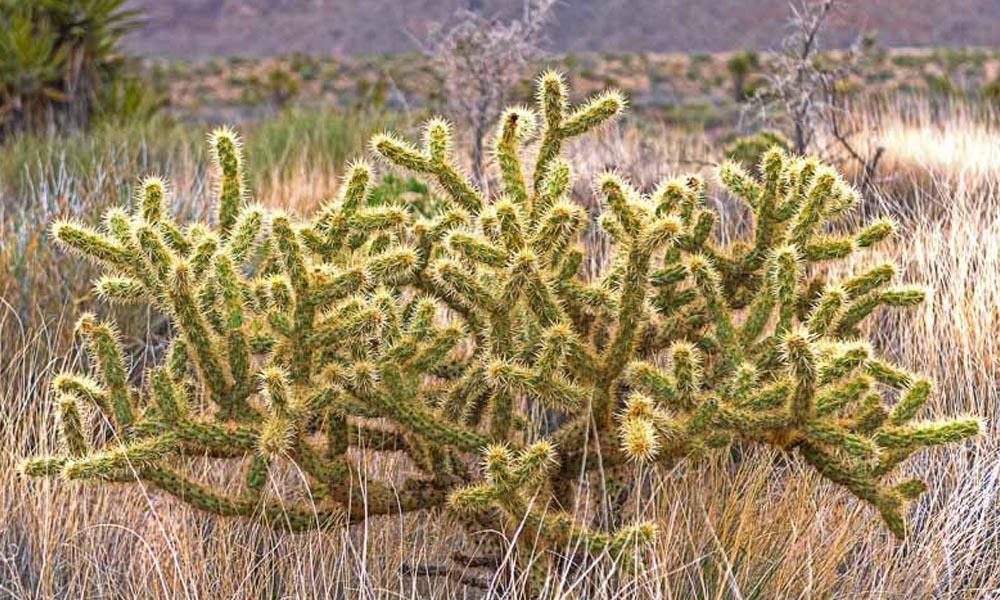The Sonoran Desert, home to We-Ko-Pa Golf Club, is not only a golfer’s paradise but also a thriving ecosystem home to hundreds of fascinating and resilient plant species including the cholla cactus for which We-Ko-Pa’s first course is named. These cacti play an integral role in our local environment, providing food and shelter for hundreds of animal species throughout the desert and especially at We-Ko-Pa Golf Club. In that vein, let’s take a brief look at types of Cholla, how they integrate into the local ecosystem and what to do – or not do – when encountering these beautifully barbed plants.
Types of Cholla Cacti
There are several species of cholla cacti found in the Sonoran Desert, each with unique characteristics:
Teddy Bear Cholla (Cylindropuntia bigelovii): Despite its cute name, this cholla is anything but cuddly. Its dense covering of spines gives it a fuzzy appearance, but these spines are barbed and can easily attach to skin, fur, or clothing.
Chain Fruit Cholla (Cylindropuntia fulgida): Known for the chains of fruit that hang from its branches, this species can grow quite large, forming tree-like structures. The fruits are a source of food for various desert animals.
Staghorn Cholla (Cylindropuntia versicolor): Named for its branching, antler-like structure, the Staghorn Cholla is particularly colorful, with spines that range in hue from purple to orange.
Buckhorn Cholla (Cylindropuntia acanthocarpa): This species is distinguished by its narrow, cylindrical stems and spines that are slightly less dense than those of other chollas, giving it a less intimidating appearance.
Ecological Importance of Cholla Cacti
Cholla cacti are more than just a prickly presence in the desert; they are integral to the survival of many species. The cactus wren, for example, nests within the dense, thorny branches of cholla cacti, which provide excellent protection from predators. The fruits of the Chain Fruit Cholla are a vital food source for animals like the desert tortoise and bighorn sheep, especially during the harsh, dry months.
Moreover, the cholla’s ability to thrive in extreme conditions, with minimal water, showcases the incredible adaptability of desert flora. Their presence helps stabilize the soil and reduce erosion, contributing to the overall health of the desert ecosystem.
What Not to Do When Encountering Cholla Cacti
While cholla cacti are fascinating and beautiful in their own right, they can pose significant hazards to those unfamiliar with their nature. Here’s a quick list of what not to do when you encounter them:
Do Not Touch: Cholla spines are incredibly sharp and barbed, meaning they can easily penetrate skin or clothing. Even the slightest brush against a cholla can result in painful and difficult-to-remove spines embedded in your skin.
Avoid Kicking or Throwing Objects at Them: Disturbing a cholla can cause its segments to detach and “jump” onto you or your companions. These segments are notorious for sticking to anything they touch.
Don’t Attempt to Remove Spines with Bare Hands: If you do end up with spines in your skin, use a comb or tweezers to remove them. Attempting to pull them out with your fingers often drives the barbs deeper.
Stay on Designated Paths: When hiking or exploring areas like We-Ko-Pa, staying on marked trails will help you avoid unwanted encounters with chollas and other potentially hazardous desert plants.
Appreciating Cholla Cacti Safely
The cholla cactus, with its spiny exterior and tough demeanor, embodies the spirit of the Sonoran Desert. By appreciating these plants from a safe distance and respecting their place in the ecosystem, we can enjoy the beauty of the desert while ensuring our safety and that of its delicate inhabitants. Whether you’re playing a round of golf at We-Ko-Pa or hiking nearby trails, take a moment to admire these remarkable cacti—just don’t get too close!







